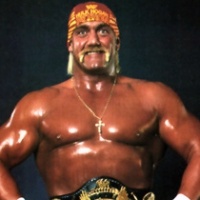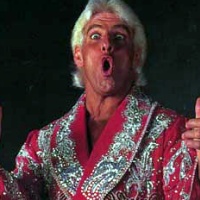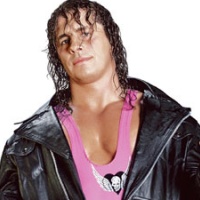
Wrestling History (From My Recollection): Part 1
May 12th, 2012 by Gavok | Tags: bret hart, hulk hogan, ric flair, steve austin, wcw, wrestling, wwfI talk about wrestling a lot. I’d like to think that in my 20+ years of following it, I know at least a thing or two. I’ve said it a million times before, but to reiterate, it really is the most intriguing and fascinating business. Maybe that’s why I shrugged off the whole Before Watchmen/Alan Moore controversy going on in the comic world because honestly, that’s nothing compared to the petty and deplorable stuff I’ve seen in the wrestling business and I’m too jaded to care. It has its ups and it has its downs, but ultimately, the history of it all tends to be more entertaining and worth paying attention to than the scripted stories they’re portraying. After all, it’s a business run by power-hungry egomaniacs who act like man-children with many of them either delusional or on drugs.
Just because I thought it would be fun to write about, I thought I would go through the basic history of wrestling in the United States. Something to educate the outsiders looking in, the new viewers who are curious, the people who’ve skipped around, those who stopped watching years ago or the longtime fans who wouldn’t mind sitting back and enjoying a refresher. I want to make this accessible, so I’m going to stray from most insider terms. Since it’ll annoy me, there are some exclusions, so let me get these out of the way:
Face: good guy
Heel: bad guy
Turn: go from good to bad or vice versa
Push: promote and move up the card
Bury: drop down the card or make someone look foolish
Booker: writer
I should reiterate that this is my take on everything. I’m sure it isn’t accurate, but I figure it’s close enough. Again, I only intend to cover the US stuff, since I don’t know the slightest about Mexico, Canada, Japan or Europe.
Professional wrestling started up in the late 19th century, usually in the form of a carnival sideshow. At first, it was a legitimate fight, usually between the wrestler and anyone who thought they could take him, but over time, the brains behind the operations realized that if the challenger was in on it, they could make more money with less risk. The popularity spread across the decades enough that federations were built up, each with their own championship and everything. The territory days made it pretty easy for a wrestler to keep himself fresh, as once things got sour, they were able to simply move on to the next territory and start anew. For instance, a wrestler could gain a reputation as an unbeatable monster villain, eventually make a couple other wrestlers look better by beating him. Eventually, he’ll lose his fictional luster and is no longer considered much of a threat, but then he can travel elsewhere and be seen as an unbeatable monster again, starting the cycle over.

The first wrestler to truly catch the public’s eye was Gorgeous George, a heel who decided to add an excessive amount of flair to his pretty boy character to the point that the fans were in a frenzy whenever he showed up. He was rude, vain, pampered and insulting and the fans paid hand over fist for the possibility of seeing someone shut him up. With the advent of television, he became a media superstar and would be credited for inspiring Muhammad Ali’s charismatic personality.

With the territory system, many federations were able to coexist without too many problems and they even did business with each other regularly. Vince McMahon Sr., who ran the World Wide Wrestling Federation, would rent out his superstar Andre the Giant to other territories and bring them huge business. In the early 80’s, Vince Sr. sold the WWWF to his son Vincent Kennedy McMahon, a genius in his own right who has more issues than Time Magazine. Soon after Vince Sr.’s death, his son went against the big territorial truce and decided to dominate professional wrestling. While wrestling companies were shown on local TV, Vince made his renamed World Wrestling Federation national and overshadowed the rest of the market. He bought off the biggest names from different territories and stacked up the WWF to the point that it was like the Yankees.

The WWF’s poster boy was Hulk Hogan, an entertaining big man who became a breakout star after appearing in Rocky 3 as Thunderlips. McMahon started a partnership with the then-new cable channel MTV as a way to team up and play off each other in the name of promotion. The Rock ‘n’ Wrestling Connection was created, pushing both sides harder into the media limelight. McMahon incorporated as many celebrities as possible, leading to the first installment of his big event Wrestlemania. While the show is a bit rough to watch due to today’s standards, the main event, which featured Hogan teaming up with Mr. T, helped it do gangbusters.
Most of the territories died out over time. A lot of it due to the WWF’s dominance and some of it due to their own foolishness. Take the American Wrestling Association, for instance. This is a company known for being founded and run by Verne Gagne, a wrestler who pretty much put himself front and center for as many years as possible. He had Hulk Hogan on the roster and despite his huge popularity, refused to make him the champion. Instead, he tried to push his less popular friends and even family more, leading to Hogan taking McMahon’s offer to leave AWA. Putting a wrestler in charge is something that tends to kill the product and this won’t be the last time this happens by far.
The territories died out and billionaire Ted Turner prevented it from becoming a total monopoly. He bought up World Championship Wrestling, while giving it airtime on his channel TBS. Thus began a war between WWF and WCW that went pretty one-sided for years. The main difference between the two was how WWF was about larger-than-life characters with colorful gimmicks taking part in scaled down superhero fights. Or as McMahon coined it, “sports entertainment”. WCW focused on the wrestling aspect, treating the show like it was a sport with tradition and honor, albeit fictional. These are just generalizations, though, as WWF had tons of talent capable of having an honest-to-God watchable match while WCW had a lot of goofy gimmicks. It’s just that when WCW had a gimmicky character, it was usually face-palmingly terrible, especially in comparison to what WWF was usually able to pull off. Also, their in-story rules and regulations had a tendency to make the show LESS fun. For a while, it was illegal for wrestlers to throw each other over the top rope or even jump off the top rope.
In the 80’s, Hulk Hogan was the focus of the WWF, especially after beating Andre the Giant at Wrestlemania 3 – the first Wrestlemania to come off as an epic production – which was recognized as a major passing of the torch. Hogan became a major household name and brought the company some definite mainstream attention. At the same time, Hogan was like a leader to the locker room, respected by most. It wasn’t hard to get into his matches, where he’d get thrashed down for most of it by his opponent, only to spring to life towards the end and act like Popeye after eating his spinach. Hogan stayed on top during this time and even when they tried to push others as champion like Randy Savage and the Ultimate Warrior, Hogan still remained the focus. This started to lead to backlash as not only were his matches always the same, but his storylines tended to have the same pattern. They were always some variation or combination of 1) an unbeatable monster targeting him, 2) a former friend becoming corrupt and blaming Hogan or 3) some anti-American guy was antagonizing him. Going into the 90’s, fans started to grow tired of this.

WCW’s top guy was Ric Flair, a very loud and suave heel who proceeded to hold the world title many times over through trickery, cheating and the help of his friends, the Four Horsemen. In the early 90’s, Flair was at odds with the head booker Jim Herd, who didn’t think Flair deserved to be at this top spot, and got fired. Flair was the champ at the time and WCW had an interesting system when it came to carrying the big belt. You had to put down a $25,000 deposit to hold the title and upon dropping the belt to the next champ, you got your money back along with interest. In other words, being champion longer in storyline led to you becoming legitimately richer. Flair demanded his promised money, Herd told him to go fuck himself and Flair got his ultimate revenge. Not only did he go to the WWF, but he brought the WCW title – which was his legal property at the time – and ranted and raved that he was the “real world’s champion”. Also, when WCW tried to crown a new champion at their next pay-per-view, the crowd hated on everything and constantly chanted, “WE WANT FLAIR!” There was a major shitstorm behind the scenes and eventually Flair returned the belt to WCW while getting his deserved money.
Flair stayed in WWF for about a year and a half where they strangely didn’t capitalize on the big money match of Hogan vs. Flair. Apparently, they tested it out on non-televised shows and it didn’t look as good as they had hoped. Flair held the WWF title twice and during the second time, he got badly injured and needed to drop it ASAP so he could take some time off. At the time, WWF was under fire for allegations of steroid use at a time when everyone was on the juice. With that pressure mixed with the sudden need to crown a new champion, they gave the spot to Bret “The Hitman” Hart, a popular wrestler from the middle of the card who was noticeably smaller than the likes of Hogan, but got the crowd behind him with his entertaining wrestling ability rather than an over-the-top personality.

Unfortunately, Hart’s victory wasn’t televised and came out of nowhere, so while they were able to build him up as a fighting champion who beat up challengers on an almost weekly basis, he still lacked the right rub to make him seem like a legit #1 guy. He needed a big win. Around this time, WWF introduced a 500 lbs. wrestler with a Japanese sumo gimmick (even though he was Samoan) named Yokozuna and pushed him up the ranks as an unbeatable force. Hart vs. Yokozuna was the main event of Wrestlemania 9, where Hogan made his return after nearly a year off TV. The ending of the show lives on in infamy as Yokozuna defeated Hart via cheating and then demanded that Hogan challenge him for the championship on the spot. Hogan came in, won via Yokozuna’s cheating backfiring and became the champion out of nowhere. This was to set up a big pay-per-view match down the line where Hogan would take on Hart and lose the title, thereby making Hart look like a big deal and acceptable champion for decisively defeating the company’s top name.
Instead, Hogan pulled a political hissyfit and refused. His relationship with McMahon became heated and he ended up leaving WWF for WCW, though first dropping the title to Yokozuna at the next available PPV show. Hart eventually got the title back, but had a far harder upward battle to become a popular #1 guy. While Hogan appeared to be a pretty political guy, this seemed to be the first major step to a downward spiral that would destroy his credibility in the business. For eight years, the man was the icon of wrestling. He still has pop culture notoriety, but back then he was on top of the world. He deserved every bit of success he had. Only he then started to realize that his career was passing its peak and did everything possible to hold onto the spotlight, especially if it meant screwing over more deserving people.

Hogan moved onto WCW, where he finally got his marquee match with Ric Flair that the WWF passed on a year earlier. Bringing Hogan in was the idea of Eric Bischoff, a former announcer who became the man who ran WCW. Not only did he bring in Hogan, but he brought in a bunch of his old friends who were on the way out of WWF. Viewers would get to see the likes of Randy Savage, “Hacksaw” Jim Duggan, Earthquake, the Big Boss Man and others move on to WCW, mostly in altered versions of their old personas (like how Earthquake became known as Avalanche for legal reasons). The influx of known talent came at a cost, as some of WCW’s rising young talent ended up getting the ax one way or another. Most notable was “Stunning” Steve Austin, who was told by Bischoff that he didn’t think he’d ever really catch steam looking as generic as he did. WCW fans were mostly purists who wanted to watch in-ring athletics that took the form of a faux sport rather than the superhero goofiness that Hogan and his buddies brought, so they grew weary of Hogan’s presence very quickly. Especially when one PPV had Hogan and Savage team up to defeat a team of eight opponents calling themselves the Alliance to End Hulkamania.

Around this time, a third company popped up. Eastern Championship Wrestling became Extreme Championship Wrestling and was run by Paul Heyman, another genius of a wrestling booker who unfortunately had a history with money problems. In a federation where weapons were allowed and most of the rules were out the window, Heyman had a talent for taking wrestlers of all shapes and sizes, seeing their pros and cons and writing his matches based on hiding their flaws. Showing up on TV late at night in syndicated form, ECW caught fire with the crowds who were sick of WWF and WCW’s silliness and wanted a more solid show with a more mature edge to it.
Tomorrow: WCW gains traction and then proceeds to put the WWF in traction.

As someone who doesn’t know anything about this part of pop culture, I appreciate someone laying all of this out. The whole spectacle has had a big influence on contemporary American society given the number of viewers, bigger than a lot of folks want to admit, probably, so thanks.
As always, excellent article Gavok. I love how you’re able to put complex and somewhat absurd stories and make them sound entertaining. Following this series.
You’re buying into WWF rewritten history with Andre passing the torch to Hogan @ WM 3. Hogan had been the champ for 5 years @ that point and would drop the title six months later (and be gone from WWF TV & house shows during the year Savage was champ between WM 4 & 5). As someone who went to every Spectrum house show back then, Andre only came thru a couple of times a year – maybe he once did a run-in to save Bobby Heenan. It was pretty noticable he wasn’t moving too good in the ring. I always gave him credit for doing the clean job to Hogan tho.
@d:
So wait . . . you’re saying Andre the Giant’s wins were . . . staged?
Foley and Austin, the two WCW rejects that helped WWF win the Monday Night Wars.
On that note, here’s (the future) Stone Cold impersonating Hulk Hogan
http://youtu.be/mW25Ad-wS9g
@d: Hogan may have been champ all that time, but Andre was still considered a pretty legendary dude, even if he was still depressingly past his prime. It’s not really WWE whitewashing that makes it a passing the torch situation but Hogan’s actions in the decades that follow. It’s a stark contrast to Hogan’s reluctance to do for younger guys what Andre did for him.